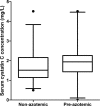Serum Cystatin C Concentrations in Cats with Hyperthyroidism and Chronic Kidney Disease
- PMID: 27155206
- PMCID: PMC5084826
- DOI: 10.1111/jvim.13956
Serum Cystatin C Concentrations in Cats with Hyperthyroidism and Chronic Kidney Disease
Abstract
Background: Currently, no test can accurately predict the development of azotemia after treatment of hyperthyroidism. Serum cystatin C concentrations (sCysC) might be less influenced by changes in body muscle mass and so better indicate the presence of concurrent chronic kidney disease (CKD) in hyperthyroidism.
Hypotheses: sCysC will be higher in hyperthyroid cats that develop azotemia compared with hyperthyroid cats that remain nonazotemic after treatment; sCysC will be higher in nonhyperthyroid cats with azotemic CKD than healthy older cats and, sCysC will decrease after treatment of hyperthyroidism.
Animals: Ninety-one cats treated in first opinion practice.
Methods: Case-control study. sCysC were compared between hyperthyroid cats which developed azotemia within 4 months of successful treatment of hyperthyroidism (pre-azotemic group) and hyperthyroid cats which remained nonazotemic after treatment (nonazotemic group), and between nonhyperthyroid cats with azotemic CKD and healthy older cats. sCysC were also compared between hyperthyroid cats before treatment and at time of establishment of euthyroidism. Data are presented as median [25th, 75th percentile].
Results: Baseline sCysC were not different between the pre-azotemic and nonazotemic groups (1.9 [1.4, 2.3] mg/L versus 1.5 [1.1, 2.2] mg/L, respectively; P = .22). sCysC in nonhyperthyroid cats with azotemic CKD and healthy older cats were not significantly different (1.5 [1.0, 1.9] mg/L versus 1.2 [0.8, 1.4] mg/L, respectively; P = .16). sCysC did not change significantly after treatment of hyperthyroidism (pretreatment 1.8 [1.2, 2.3] mg/L, after treatment 1.6 [1.1, 2.4] mg/L; P = .82).
Conclusions and clinical importance: sCysC do not appear to be a reliable marker of renal function in hyperthyroid cats.
Keywords: Azotemia; Clinical chemistry; Clinical pathology; Endocrinology; Renal function; Thyroid; Urinary tract; Validation.
Copyright © 2016 The Authors. Journal of Veterinary Internal Medicine published by Wiley Periodicals, Inc. on behalf of the American College of Veterinary Internal Medicine.
Figures



Similar articles
-
Evaluation of Cystatin C for the Detection of Chronic Kidney Disease in Cats.J Vet Intern Med. 2016 Jul;30(4):1074-82. doi: 10.1111/jvim.14256. J Vet Intern Med. 2016. PMID: 27461722 Free PMC article.
-
Evaluation of Serum Symmetric Dimethylarginine Concentration as a Marker for Masked Chronic Kidney Disease in Cats With Hyperthyroidism.J Vet Intern Med. 2018 Jan;32(1):295-304. doi: 10.1111/jvim.15036. J Vet Intern Med. 2018. PMID: 29377360 Free PMC article.
-
Hyperthyroid cats that develop azotemia following successful radioiodine treatment have shorter survival times compared to cats that remain nonazotemic.J Am Vet Med Assoc. 2024 Dec 26;263(4):454-459. doi: 10.2460/javma.24.10.0653. Print 2025 Apr 1. J Am Vet Med Assoc. 2024. PMID: 39724773
-
Diagnostic accuracy of serum cystatin C in chronic kidney disease: a meta-analysis.Clin Nephrol. 2015 Aug;84(2):86-94. doi: 10.5414/cn108525. Clin Nephrol. 2015. PMID: 26200185 Review.
-
Hyperthyroid cats and their kidneys: a literature review.Aust Vet J. 2022 Sep;100(9):415-432. doi: 10.1111/avj.13179. Epub 2022 Jun 16. Aust Vet J. 2022. PMID: 35711100 Free PMC article. Review.
Cited by
-
Assessment of the association between diabetes mellitus and chronic kidney disease in adult cats.J Vet Intern Med. 2019 Sep;33(5):1921-1925. doi: 10.1111/jvim.15559. Epub 2019 Jul 15. J Vet Intern Med. 2019. PMID: 31305000 Free PMC article.
-
Renal Biomarkers in Companion Animals-A Review.Animals (Basel). 2025 Mar 13;15(6):818. doi: 10.3390/ani15060818. Animals (Basel). 2025. PMID: 40150347 Free PMC article. Review.
-
Renal biomarkers in cats: A review of the current status in chronic kidney disease.J Vet Intern Med. 2022 Mar;36(2):379-396. doi: 10.1111/jvim.16377. Epub 2022 Feb 26. J Vet Intern Med. 2022. PMID: 35218249 Free PMC article. Review.
-
Changes in thyroid and renal function after bilateral thyroidectomy in cats.J Vet Intern Med. 2019 Mar;33(2):508-515. doi: 10.1111/jvim.15450. Epub 2019 Feb 13. J Vet Intern Med. 2019. PMID: 30758070 Free PMC article.
-
Efficacy of Urine Asymmetric Dimethylarginine Concentration to Predict Azotemia in Hyperthyroid Cats After Radio-Iodine Treatment.J Vet Intern Med. 2025 May-Jun;39(3):e70096. doi: 10.1111/jvim.70096. J Vet Intern Med. 2025. PMID: 40271736 Free PMC article.
References
-
- Shiel RE, Mooney CT. Testing for hyperthyroidism in cats. Vet Clin North Am Small Anim Pract 2007;37:671–691, vi. - PubMed
-
- Williams TL, Elliott J, Syme HM. Association of iatrogenic hypothyroidism with azotemia and reduced survival time in cats treated for hyperthyroidism. J Vet Intern Med 2010;24:1086–1092. - PubMed
-
- Uchida K, Gotoh A. Measurement of cystatin‐C and creatinine in urine. Clin Chim Acta 2002;323:121–128. - PubMed
-
- den Hollander JG, Wulkan RW, Mantel MJ, Berghout A. Is cystatin C a marker of glomerular filtration rate in thyroid dysfunction? Clin Chem 2003;49:1558–1559. - PubMed
MeSH terms
Substances
LinkOut - more resources
Full Text Sources
Other Literature Sources
Medical
Miscellaneous

